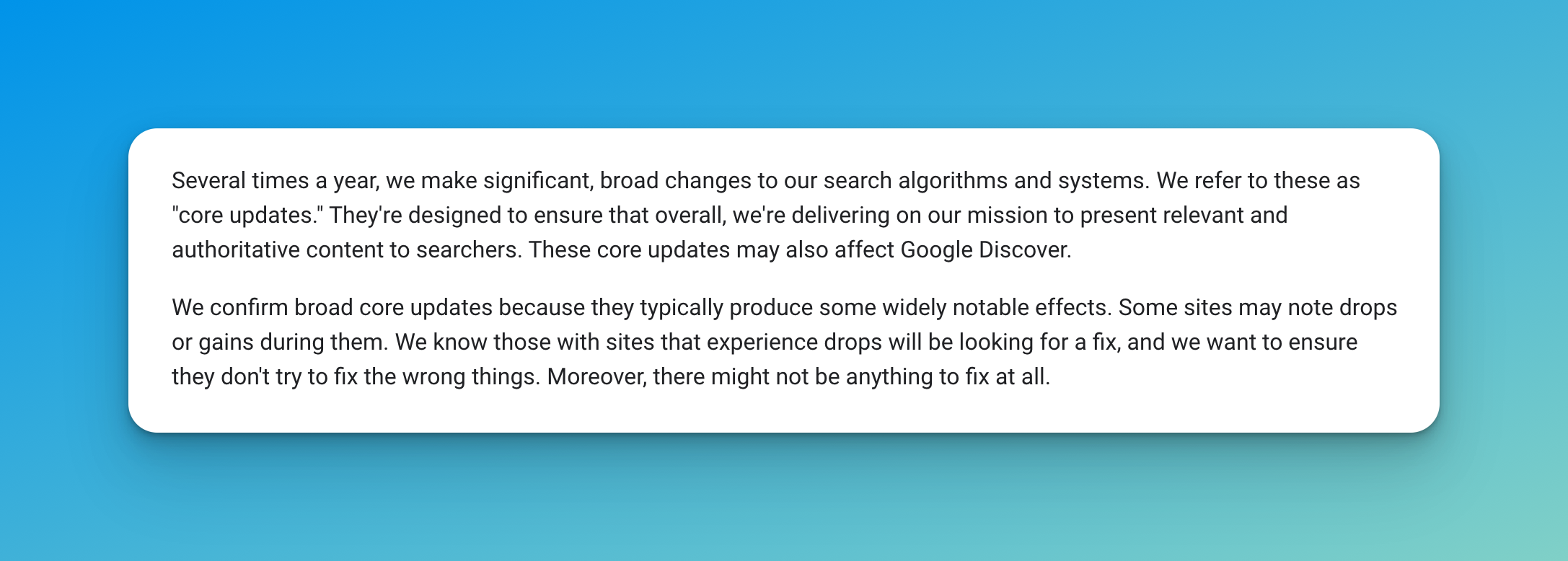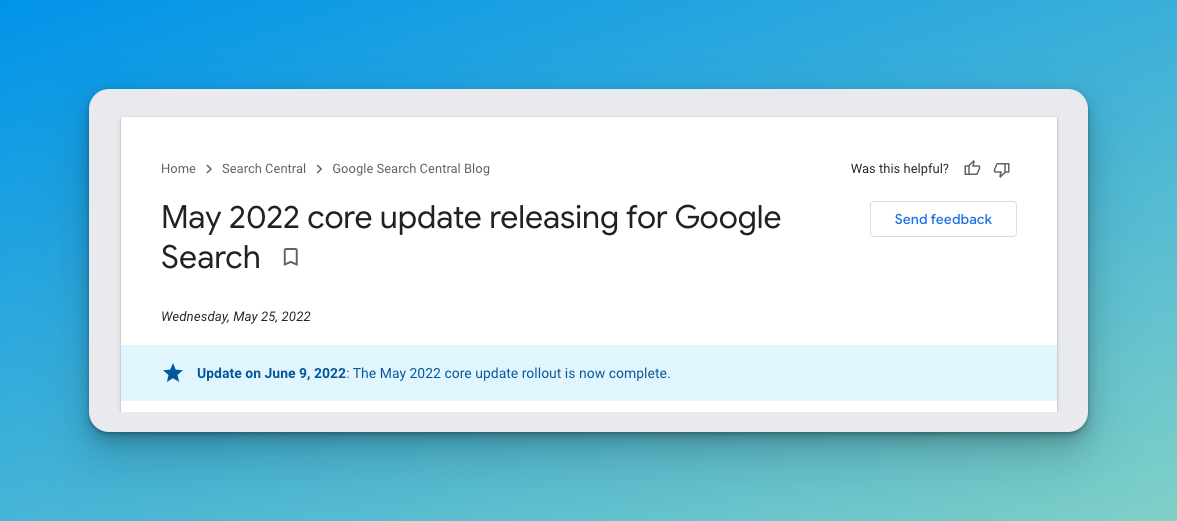There’s no denying that Google is the king of the search engine landscape, and it’s continually updating its ranking algorithm to ensure that it stays in top position. These changes are known as ‘Core Updates’ and they’re something that all SEOs need to stay up to date on in order to rank well.
What Are Google Core Updates?
Core Updates are significant changes that Google makes to its ranking algorithm, affecting a large number of indexed web pages. Google carries out these updates throughout the year; they’re designed to make search results more relevant.
Web pages that rank well for their target keywords may find that following a core update, they suddenly rank lower, and vice versa. Some of Google’s most notable updates have been:
- Penguin
- Panda
- Hummingbird
- Rankbrain
What Are Google Algorithms?
The algorithms Google uses are complex, but they’re designed to gather data from its search index so that it can provide the best results for a search query. Google uses multiple algorithms and ranking factors when delivering the web pages based on relevancy in the search engine result pages or SERPs. While Google would only make a few updates to its algorithms in its early days, now thousands of changes take place every year.
Core Updates vs Minor Updates
Alongside core updates, Google also carries out minor updates to the ranking algorithms. These minor updates consist of changes that are targeting the quality and relevance of the search results and affect fewer indexed web pages as a result. While a core update can affect between 5-10% of all searches, minor updates are closer to 1%, and are often so trivial that they don’t even get noticed. What’s more, minor updates are a lot more common than core updates and take place on a daily basis, compared to every few months for core updates.
How Do Google Core Updates Affect SEO?
Core updates can have a significant impact on SEO, as they impact the ranking algorithm that affects the position of web pages in the SERPs. So when you invest time and energy into optimising your website for Google, a core update could render your hard work meaningless if it eliminates ranking factors that you’ve been working on optimising.
Core Updates can also impose penalties on your website that can obliterate your search rankings. The Panda update, for example, imposed algorithmic penalties on sites with minimal content, affecting sites that previously could rank highly without needing to publish much content.
Core Updates may affect more than just rankings too, restructuring the results pages to modify alternative listings, like featured snippets or Knowledge Graph panels.
How To Tell When A Core Update Is Going To Happen
Google confirms most core updates since they have strong effects on sites, either losing or gaining rankings as a result of them, but it doesn’t announce all of them.
Unless Google specifies the nature of an update, no one knows precisely when they will happen or what they’ll involve. The key is to stay prepared as much as possible to minimise the impact they’ll have on the site. Working with a digital marketing agency can also help you avoid any SEO disasters – as experts in the industry, they’ll keep an eye on Google’s changes and updated requirements, so you don’t have to.
Can You Prepare Your Website For Core Updates?
There are several ways you can prepare your website for core updates. The first step is to do your research – read up on what the purpose of the update is when Google announces it and find out what it will affect so you can put plans in place to minimise any potential damage. With this knowledge, you can make the right tweaks to your website, so it’s aligned with the upcoming update.
Since core updates are designed to improve the quality of the search results, it’s worth paying attention to the quality of the content on your site, and less on the off-site promotion. While creating backlinks might offer some benefits, content is where your efforts should lie if you want to fully prepare for Google’s updates. You should also ensure you’re avoiding any manipulative SEO practices as these are almost certainly going to result in your site rankings dropping and being penalised.
Google Core Updates From The Past Two Years
2022 – May 2022 – Google announced the release of the May 2022 Core Update, part of a series of updates to the overall ranking process.
2022 – Product Review Ranking Update –This update was to the product review rankings to enable Google to identify high-quality reviews.
2021 – Page Experience Update – Google started rolling this update out mid-June after an initial postponement, introducing key metrics such as Core Web Vitals into rankings.
2020 – May Core Update – Due to the pandemic, search intent changed considerably so Google made it easier for people to find the answers they were searching for.
2020 – E.A.T Update – The focus of this update was on Expertise, Authoritativeness and Trustworthiness. Content that aligns with these values ranks better, along with content that’s attributed to superior user experience.
2019 – BERT – Referring to Bidirectional Encoder Representations from Transformers, this update works on Natural Language Processing to help Google understand context more effectively.
2019 – Site Diversity – This update sought to eliminate multiple listings from the same domain from the SERP, so multiple listings are seen less often.
2018 – “Medic” Core Update – Google didn’t confirm the specific purpose of this update but it had a large impact on health, finance and ‘Your Money Your Life’ (YMYL) pages. SEO experts believe the update was designed to boost the rankings of high quality articles that offered advice on major life issues.
2017 – Fred Update – Fred had an impact on organic listings with many sites experiencing a decline in traffic of between 50-90%. The goal was to crack down on sites that emphasised display ads or traffic monetisation widgets over content.
2017 – Mobile Interstitial Penalty – The SEO penalty was applied to sites running interstitial ads which blocked the view of the content on the page. It wasn’t a blanket penalty but focused on intrusive ads on mobile.
2016 – AdWords Update – This update changed the way paid search listings appeared in the SERPs, removing the 4-pack placement in the right hand column to integrate them into the main listings.
2015 – RankBrain – Google introduced AI into the algorithm, monitoring user behaviour and response to queries to learn more about intent.
2015 – The Mobile Update – This update forced all sites to become mobile-friendly, with unresponsive sites not optimised for mobile penalised.
2015 – The Quality Update – Also known as Phantom II, this update was noticed within a few weeks of the mobile update and rewarded sites that focused on user experience and high quality content.
2013 – Hummingbird Update – This change enhanced the algorithm by making it smarter at interpreting semantic search. It was created to help Google better understand context and intent behind search queries.
2012 – Penguin Update – Penguin created a further push towards quality content, targeting spam content and artificial backlink profiles.
2011 – Panda Update – This update has had several iterations over the years, but it was first launched in 2011 and targeted spam and weak content. Sites with duplicate content, thin or weak content, and too many ads were penalised.
Conclusion
With over two trillion searches taking place every year, it’s no surprise that Google updates its algorithms so often. Staying on top of these changes is essential in order to keep a high ranking position. Working with a digital marketing agency that stays abreast of SEO changes and Google updates will ensure that your site continues to perform well, without you needing to do the hard work.

